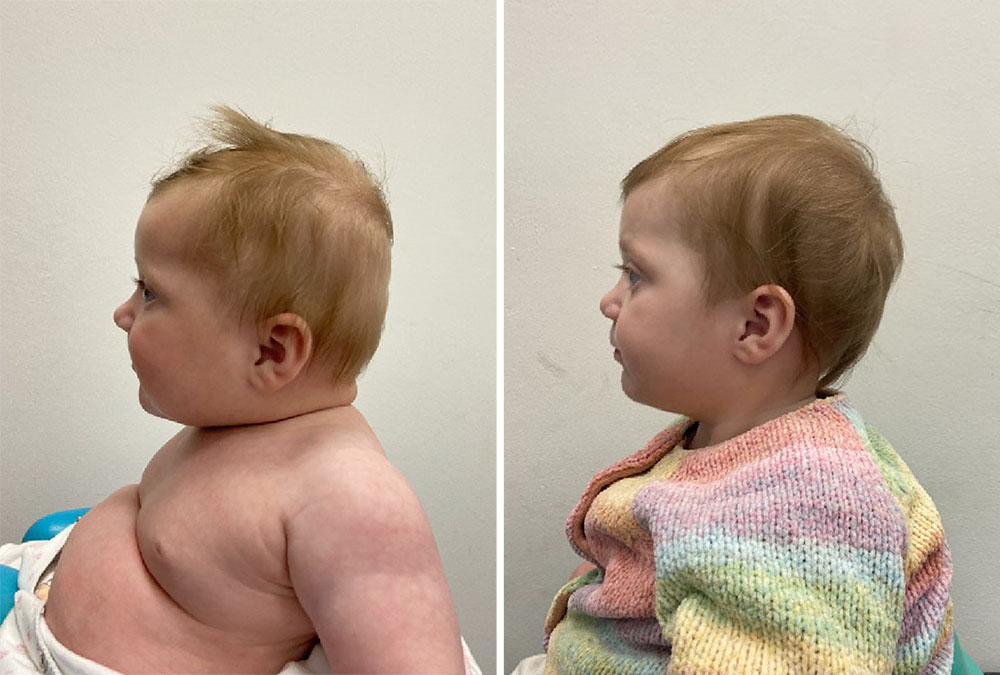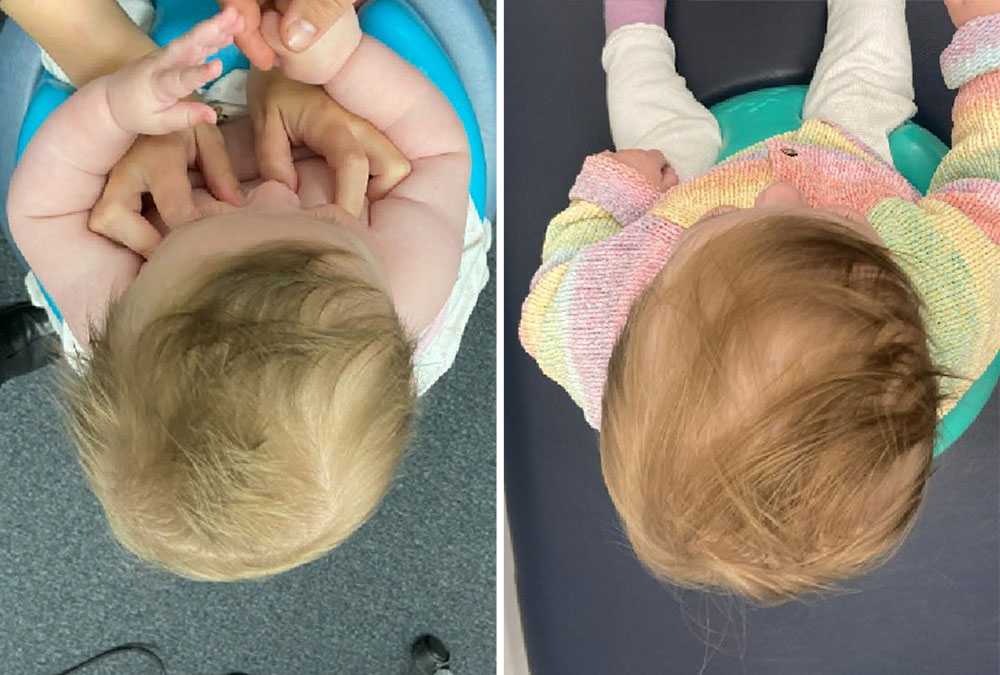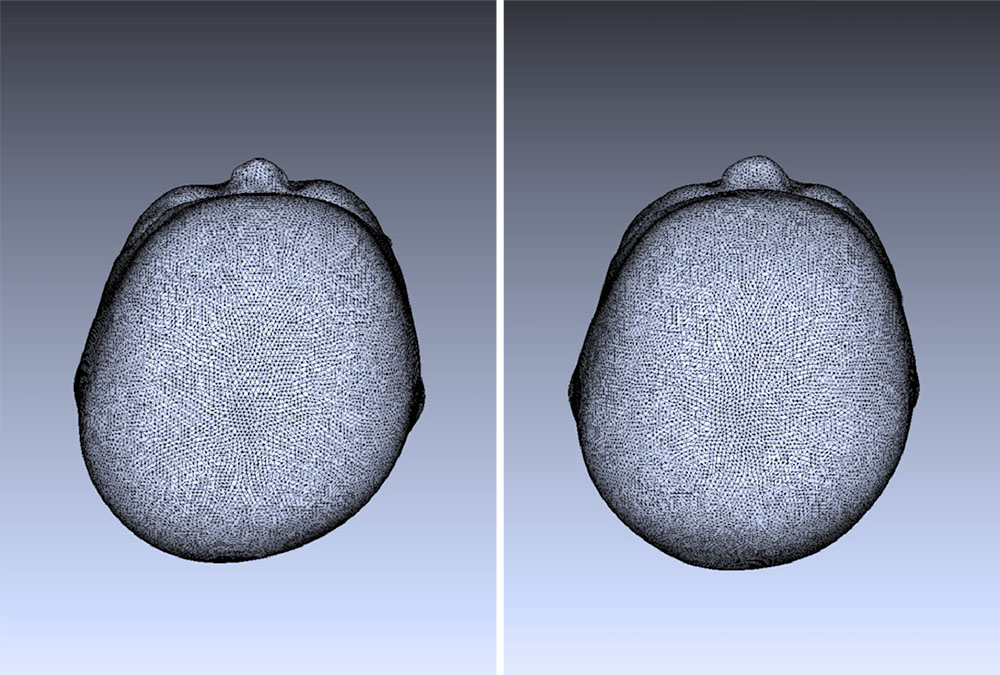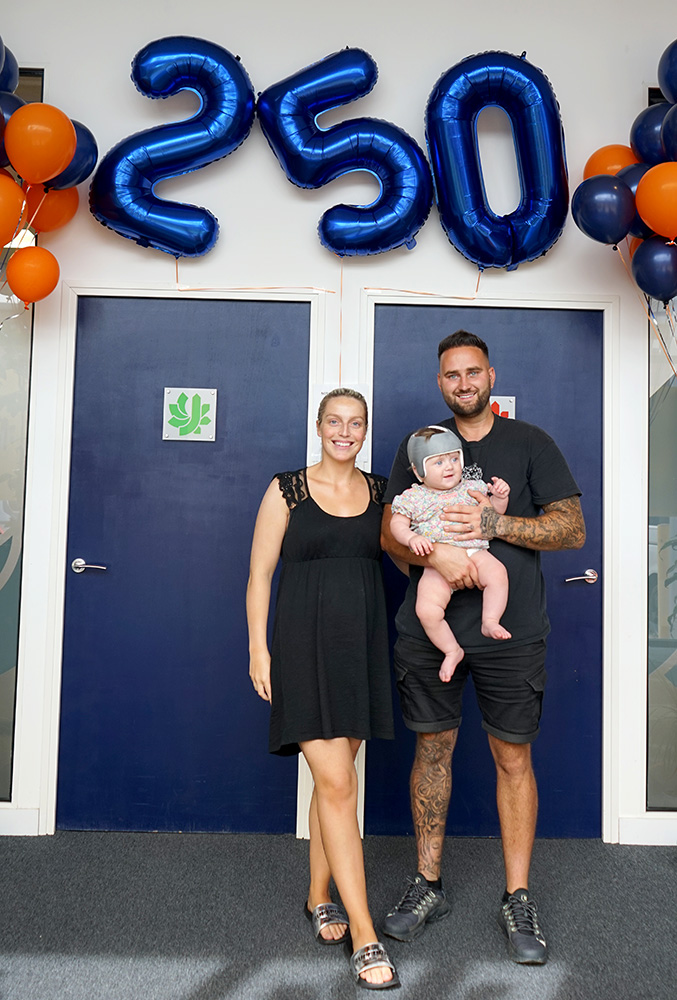
Bonnie, before and after six months of cranial remoulding therapy with the LOCband Lite helmet.
05 April 2023
Baby Bonnie's plagiocephaly improves after only 6 months in the LOCband Lite cranial remolding helmet.
Bonnie’s parents started to worry about Bonnie’s head shape when she was about 3 months old after one of her grandparents noticed her mishappen head. They saw their GP who was concerned that Bonnie might have craniosynostosis, a condition where a baby’s skull plates fuse prematurely and can restrict growth to the brain.
They were referred to Southampton Hospital but while waiting for an appointment, Jody, Bonnie’s mum, started Googling for information and found the London Orthotic Consultancy. Even though they live in Hampshire, they felt the journey to Kingston was worth it. They were still waiting for an appointment at the hospital when they decided to seek private treatment.
By the time Bonnie was assessed, she was 6 months old. Jody recalls: “I was mostly worried about the assessment process; I had a cousin who was treated some years ago and they cast his head! I need not have been concerned, Jo (Drake) our clinician took some scans and did some measurements, all calmly without fuss and Bonnie was entertained by all the attention! Jo confirmed then that Bonnie did not have craniosynostosis, which was obviously a relief.”

Bonnie's head shape before and after treatment with the LOCband Lite.
At the assessment, Bonnie was found to have severe right-sided plagiocephaly and moderately severe brachycephaly. During the assessment, a clinician takes measurements to establish the cephalic ratio. This measures the width of the skull divided by the length of the skull. The top end of the normal range is 89%, whereas Bonnie’s was 93%.
The second measurement establishes cranial vault asymmetry, which compares the left and right diagonals at 30 degrees from the centre of the head (front to back). Subtracting one from the other gives the asymmetry value. Less than 6mm asymmetry is regarded as being within the normal range of head shape, though anything 12mm and above is deemed to be severe. Bonnie’s was 12mm.

Bonnie's head shape before treatment with an asymmetry value of 12mm, and after, with a value of 4mm.
Fast forward 6 months and Bonnie had been discharged, her cephalic ratio was down to 87% and her asymmetry down to 4mm, which is considered a normal head shape.
Mum Jody says: “Bonnie didn’t care about wearing a helmet, she wasn’t fazed at all, indeed she relished being able to fall about with impunity. It’s really a quick and easy treatment, and I would recommend it to anyone. Jo was fantastic, efficient, reassuring and I think most importantly it was always possible to contact her. When you have your first child you are a bit anxious so to be able to WhatsApp Jo at any time and get a response immediately even out of clinic hours was so brilliant. Thank God we found LOC online.”
Worried about your baby’s head shape? Fill out our free Flat Head Diagnosis Form or, to book a free consultation with an orthotist, contact us.

Bonnie with parents at her second review appointment
The LOCband is non-invasive and works by applying gentle, constant pressure over the areas of the baby’s skull that are most prominent while allowing unrestricted growth over the flattened areas. The band consists of a soft foam layer inside a thermoplastic shell. As the baby grows, the band will be adjusted frequently to gently guide the skull into a more symmetrical shape.
The optimum age for treatment is between four and seven months.
This is because the skull is most malleable at this age and improvements to head shape tend to take less time and are more dramatic. That is not to say that helmet therapy should be ruled out if the baby is older than seven months. Routinely, babies up to the age of 16 months can be treated very successfully.
The cut off age is around 18 months when the fontanelles (soft spots on the head) are no longer malleable. As babies grow and develop at different rates, it is always worth checking if you are not sure. There have been cases where a baby’s fontanelles have not fused yet by the age of 18 months, who have achieved successful, but less-marked results with cranial remoulding therapy.
Yes - All babies that have completed their course of treatment with us have achieved a measurable improvement in head shape. However, you don’t have to take our word for it.
Recent independent research conducted by a University Hospital in Germany has endorsed the treatment for babies with moderate or severe plagiocephaly.
A larger, retrospective study has just been published that found complete correction was achieved in 94.4% of babies treated with helmet therapy.
The results were conclusive: repositioning achieved acceptable correction in 77.1% of cases, but 15.8% were moved onto helmet therapy because re-positioning was not working. Meanwhile, 94.4% of the infants who started in the helmet-treated group achieved full correction, as did 96.1% of those who were transferred from the repositioning group into the helmet-treated group.
Further information can be found on our Plagiocephaly Research page.
This is very much dependent on how fast your baby is growing. The faster the growth, the more frequently your baby will be seen so that the helmet can be adjusted. In general, reviews will happen at two to four-week intervals.
The price of treatment covers: